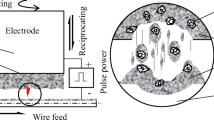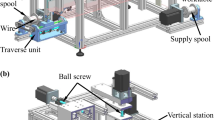Abstract
Due to their excellent physical and mechanical properties, third-generation super-hard semiconductor materials (such as SiC, GaN) are used widely in the field of microelectronics. However, due to its ultra-high hardness, the machining is very difficult, which has become the bottleneck of its development. Slicing is the first machining procedure that directly affects the subsequent process. Fixed abrasive diamond wire saw (DWS) has been widely used in cutting hard and brittle materials. However, the diamond abrasives are attached to a core wire by resin or electroplated, that slicing super hard crystals is very difficult and inefficient. In order to improve the slicing efficiency, it is necessary to improve the holding strength and wear resistance of the DWS. The electro-spark deposition (ESD) process can deposit electrode materials on the substrate under the condition of low heat input to achieve metallurgical bonding between metal materials. And it can improve the wear resistance, corrosion resistance, and repair the size of the workpiece. It has been widely used in the field of surface modification engineering. It can effectively improve the bonding strength of the abrasive grains, and the sawing ability of the wire saw to make the consolidated DWS by the ESD process. Due to its thin matrix and poor thermal properties, the saw wire is easy to burning or even breaking in the manufacturing process. At present, the selection of pulse interval time in the ESD process is generally determined by the duty factor. However, the pulse interval time selected according to duty factor is difficult to meet the heat dissipation requirements of electro-spark deposition DWS (ESDDWS). In this paper, two kinds of motion modes of ESDDWS manufacturing are put forward, according to the manufacturing characteristics of ESDDWS. The boundary conditions of the continuous pulse discharge of ESDDWS are established. The thermal simulations of continuous pulse discharge of ESDDWS under two motion modes are analyzed. According to the simulation results, the basis of the value of pulse interval in the ESDDWS process is put forward. The effect of pulse interval time on the mechanical performance of the wire saw is analyzed experimentally. The results show that selected the discharge interval time base on the simulation results can ensure the continuous production of the ESDDWS.








Similar content being viewed by others
Data availability
The data and materials supporting the results of this article are included within the article.
Abbreviations
- c :
-
Specific heat capacity
- h :
-
Convection heat coefficient
- I :
-
Discharge current
- k :
-
Thermal conductivity
- m :
-
Number of discharge
- q 0 :
-
Maximum heat flux
- R :
-
The radius of the plasma channel
- R j :
-
The radius of the saw wire
- r :
-
Coordinates of cylindrical work domain
- T :
-
Temperature
- T 0 :
-
Environment temperature
- t :
-
Time
- t on :
-
Pulse duration time
- t off :
-
Pulse interval time
- z :
-
Coordinates of cylindrical work domain
- β :
-
The angle between the incident direction of the heat flow and the normal direction at a point on the core wire surface
- θ :
-
Coordinates of cylindrical work domain
- ρ :
-
Density
References
Yadlapalli RT, Kotapati A, Kandipati R, Balusu SR, Koritala CS (2021) Advancements in energy efficient GaN power devices and power modules for electric vehicle applications: a review. Int J Energ Res 45(9):12638–12664
Wellmann PJ (2017) Power electronic semiconductor materials for automotive and energy saving applications — SiC, GaN, Ga2O3, and Diamond. Z Anorg Allg Chem 643(21):1312–1322
Gao Y, Chen Y (2019) Sawing stress of SiC single crystal with void defect in diamond wire saw slicing. Int J Adv Manuf Tech 103(1–4):1019–1031
Garrido-Diez D, Baraia I (2017) Review of wide bandgap materials and their impact in new power devices. IEEE (ECMSM), Donostia-San Sebastian, Spain 1–6
Gao Y, Chen Y, Ge P, Zhang L, Bi W (2018) Study on the subsurface microcrack damage depth in electroplated diamond wire saw slicing SiC crystal. Ceram Int 44(18):22927–22934
Chung C, Tsay GD, Tsai M (2014) Distribution of diamond grains in fixed abrasive wire sawing process. Int J Adv Manuf Tech 73(9–12):1485–1494
Huang H, Zhang Y, Xu X (2015) Experimental investigation on the machining characteristics of single-crystal SiC sawing with the fixed diamond wire. Int J Adv Manuf Tech 81(5–8):955–965
Kim D, Kim H, Lee S, Jeong H (2015) Effect of initial deflection of diamond wire on thickness variation of sapphire wafer in multi-wire saw. Int J Pr Eng Man-Gt 2(2):117–121
Huang H, Li X, Xu X (2017) An experimental research on the force and energy during the sapphire sawing using reciprocating electroplated diamond wire saw. J Manuf Sci E-T Asme 139:121011
Tsai P, Chou Y, Yang S, Chen Y, Wu C (2013) A comparison of wafers sawn by resin bonded and electroplated diamond wire — from wafer to cell. IEEE (PVSC), Tampa, FL 523–525
Liu T, Ge P, Gao Y, Bi W (2017) Depth of cut for single abrasive and cutting force in resin bonded diamond wire sawing. Int J Adv Manuf Tech 88(5–8):1763–1773
Yin Y, Gao Y, Li X, Pu T, Wang L (2020) Experimental study on slicing photovoltaic polycrystalline silicon with diamond wire saw. Mat Sci Semicon Proc 106:104779
Kim H, Kim D, Kim C, Jeong H (2013) Multi-wire sawing of sapphire crystals with reciprocating motion of electroplated diamond wires. CIRP Ann 62(1):335–338
Chung C, Nhat LV (2014) Generation of diamond wire sliced wafer surface based on the distribution of diamond grits. Int J Precis Eng Manuf 15(5):789–796
Kim D, Kim H, Lee S, Lee T, Jeong H (2016) Characterization of diamond wire-cutting performance for lifetime estimation and process optimization. J Mech Sci Technol 30(2):847–852
Kumar A, Kaminski S, Melkote SN, Arcona C (2016) Effect of wear of diamond wire on surface morphology, roughness and subsurface damage of silicon wafers. Wear 364:163–168
Kumar A, Melkote SN (2018) Wear of diamond in scribing of multi-crystalline silicon. J Appl Phys 124(6):65101
Gupta A, Chen CA, Hsu H (2019) Study on diamond wire wear, surface quality, and subsurface damage during multi-wire slicing of c-plane sapphire wafer. Int J Adv Manuf Tech 100(5–8):1801–1814
Sheldon GL, Johnson RN (1984) Electro-spark deposition: a technique for producing wear resistant coatings. Wear Mater Int Conf Wear Mater, Vancouver, Canada 14–18
Wang PZ, Pan GS, Zhou Y, Qu JX, Shao HS (1997) Accelerated electrospark deposition and the wear behavior of coatings. J Mater Eng Perform 6(6):780–784
Chakraborty S, Kar S, Dey V, Ghosh SK (2018) The phenomenon of surface modification by electro-discharge coating process: a review. Surf Rev Lett 25(01):1830001–1830003
Adam B, Wood W, Kadali J, Talla R, Langston T (2017) Heat affected zone formation in electrospark deposition additive manufacturing on ultrahigh strength steel. Mater Perform Charact 6:375–393
Peng ZL, Li YN (2012) The deposition and removal process for micro machining based on electrical discharge. Adv Mater Res 472–475:2448–2451
Jain V K, Seshank S, Sidpara A, Jain H (2013) Some aspects of micro-fabrication using electro-discharge deposition process. ASME/ISCIE (ISFA2012), St Louis, MO 419–424
Mohri N, Saito N, Tsunekawa Y, Kinoshita N (1993) Metal surface modification by electrical discharge machining with composite electrode. CIRP Annals - Manuf Techno 42(1):219–222
Furutani K, Suzuki K (2015) Experimental investigations of deposition conditions for saw wire fabrication by electrical discharge machining. Int J Adv Manuf Tech 76(9–12):1643–1651
Furutani K, Kanai M, Mieda Y, Suzuki M (2010) Proposal of abrasive layer fabrication on thin wire by electric discharge machining. Int J Automation Technol 4(4):394–398
Furutani K, Suzuki K (2009) A desktop saw wire coating machine by using electrical discharge machining. IEEE Int Conf Cont Autom, Christchurch, New Zealand 2165–2170
Li C, Ge P, Bi W (2021) Thermal simulation of the single discharge for electro-spark deposition diamond wire saw. Int J Adv Manuf Tech 114(11–12):3597–3604
Wang Y, Xie B, Wang Z, Peng Z (2011) Micro EDM deposition in air by single discharge thermo simulation. T Nonferr Metal Soc 21(s2):450–455
Shahri HRF, Mahdavinejad R, Ashjaee M, Abdullah A (2017) A comparative investigation on temperature distribution in electric discharge machining process through analytical, numerical and experimental methods. Int J Mach Tools Manuf 114:35–53
Alinia S, Khamedi R, Ahmadi I (2018) An investigation into deep drawing parameters on deformation induced martensitic microstructure transformation of an austenitic stainless steel. Metallogr Microstruct Anal 7(6):724–734
Funding
This work is financially supported by the National Natural Science Foundation of China (No. 51775317) and the Key Research and Development Program of Shandong Province, China (No. 2019JZZY020209)
Author information
Authors and Affiliations
Contributions
Chengyun Li is the executor of article writing and experiment operation. Peiqi Ge contributed to the conception of the work. Wenbo Bi contributed to the experiment preparation.
Corresponding author
Ethics declarations
Ethical approval
Not applicable.
Consent to participate
Not applicable.
Consent for publication
The authors declare that this work has not been submitted elsewhere for publication, in whole or in part.
Competing interests
The authors declare no competing interests.
Additional information
Publisher's note
Springer Nature remains neutral with regard to jurisdictional claims in published maps and institutional affiliations.
Rights and permissions
About this article
Cite this article
Li, C., Ge, P. & Bi, W. Thermal simulation of the continuous pulse discharge for electro-spark deposition diamond wire saw. Int J Adv Manuf Technol 119, 2923–2933 (2022). https://doi.org/10.1007/s00170-021-08444-x
Received:
Accepted:
Published:
Issue Date:
DOI: https://doi.org/10.1007/s00170-021-08444-x




